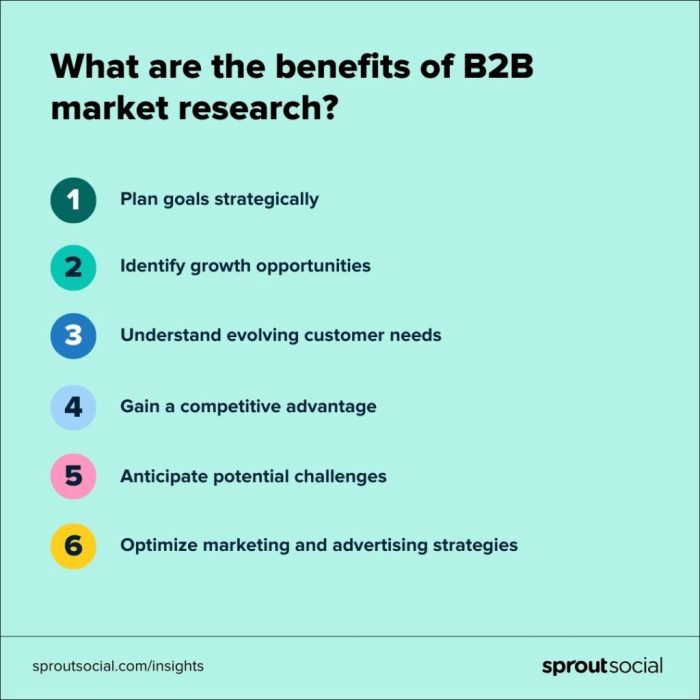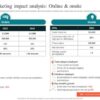What every managing partner needs to know about B2B research sets the stage for understanding the crucial role of market intelligence in driving strategic decisions. This guide dives deep into the complexities of B2B research, from defining specific needs and researching target customers to effectively utilizing data and making impactful strategic decisions. We’ll cover essential methodologies, crucial KPIs, and actionable insights that every managing partner needs to lead their teams to success.
This comprehensive exploration will empower managing partners to effectively navigate the intricate landscape of B2B research. By understanding the nuances of various research methods, effectively segmenting target markets, and leveraging data insights, managing partners can make informed decisions that foster growth and profitability. We’ll explore the practical application of research in strategic planning, implementation, and stakeholder communication.
Defining B2B Research Needs
B2B research is crucial for navigating the complexities of the modern business landscape. It’s not just about gathering data; it’s about translating insights into actionable strategies. A deep understanding of different research types, successful case studies, and effective KPIs is essential for managing partners seeking to optimize their organizations. This section dives into the specifics, providing a framework for identifying your research needs.
Types of B2B Research
B2B research encompasses a wide range of methodologies, each with its own strengths and weaknesses. Understanding these differences is critical for choosing the right approach to address specific business challenges. Primary research involves collecting original data directly from the source, such as surveys or interviews. Secondary research utilizes existing data from sources like industry reports or public databases.
Mixed methods research combines both primary and secondary research to gain a comprehensive perspective.
Examples of Successful B2B Research Projects
Numerous companies have leveraged B2B research to address critical business challenges. For example, a software company conducting primary research through surveys of potential clients identified unmet needs regarding ease of use, leading to the development of a streamlined interface. This resulted in a significant increase in customer adoption. Another example involved a manufacturing company using secondary research to analyze market trends in the automotive sector.
This analysis identified a shift in consumer preferences toward electric vehicles, prompting the company to adapt its production line to accommodate this trend. These examples demonstrate the power of B2B research to drive strategic decision-making.
Key Performance Indicators (KPIs) for Evaluating Effectiveness
Evaluating the effectiveness of B2B research is paramount. Key Performance Indicators (KPIs) provide quantifiable measures of success. Common KPIs include response rates to surveys, the quality of data gathered, the alignment of research findings with business objectives, and the resulting impact on business decisions. Tracking these metrics allows for a more rigorous assessment of the return on investment (ROI) of research efforts.
Framework for Identifying Research Needs
A structured approach is essential for identifying the specific research needs of a managing partner. This framework begins by clearly defining the business objective. What specific questions need answering? What are the potential outcomes and impact? Next, determine the scope of the research – what aspects of the business will be investigated?
Defining the target audience and the appropriate methodology is critical. Finally, establish clear metrics for measuring success, ensuring the research delivers tangible value. This iterative process ensures the research aligns with the overall strategic goals of the organization.
Comparing B2B Research Methodologies
| Methodology | Strengths | Weaknesses | Use Cases |
|---|---|---|---|
| Primary Research | Provides specific, tailored data directly from the source, offering deep insights and a high level of control over the research process. | Can be time-consuming and costly, requiring significant resources for data collection and analysis. Response rates may be low. | Understanding customer needs, identifying market gaps, and evaluating product-market fit. |
| Secondary Research | Cost-effective and relatively quick, providing access to a wide range of data and insights. | May not provide the specific data needed, potentially requiring extensive analysis to extract relevant information. Data quality and validity may be questionable. | Identifying industry trends, understanding competitive landscapes, and benchmarking against industry best practices. |
| Mixed Methods | Combines the strengths of primary and secondary research, offering a more comprehensive and robust understanding of the issue at hand. | Can be complex and time-consuming, requiring a deep understanding of both methodologies to ensure effective integration and analysis. | Exploring complex business problems that require a multifaceted approach to gain deep insight and address all aspects of the issue, ensuring validity and reliability. |
Researching Target Customers: What Every Managing Partner Needs To Know About B2b Research
Understanding your target customers is paramount to successful B2B research. Knowing their needs, pain points, and motivations allows you to tailor your offerings and messaging for maximum impact. This crucial step in the research process directly translates into higher conversion rates and stronger customer relationships. Effective B2B research relies on a deep dive into the customer’s world.Thorough customer research enables a more precise understanding of the ideal customer profile (ICP), market segmentation, and buyer personas.
This, in turn, facilitates the development of a comprehensive customer journey map. By meticulously mapping out the customer’s interactions with your company, you can pinpoint opportunities for improvement and optimize the entire customer experience.
Identifying the Ideal Customer Profile (ICP)
Defining your ideal customer profile (ICP) is critical for focused research. An ICP Artikels the specific characteristics of your most valuable customer. These characteristics include demographics, firmographics, behavioral patterns, and more. Clearly defining your ICP ensures your research efforts are concentrated on the segment most likely to convert. A well-defined ICP is the cornerstone of effective B2B marketing strategies.
Segmenting the Target Market
Effective market segmentation is essential for focused research. Dividing your target market into distinct groups based on shared characteristics allows you to tailor your research efforts to each segment’s unique needs and motivations. This targeted approach maximizes the return on investment from your research.
Creating Detailed Buyer Personas
Buyer personas are detailed representations of your ideal customers. They go beyond basic demographics, delving into psychographics, motivations, and pain points. These detailed representations of your ideal customers are invaluable tools in understanding customer behavior and decision-making processes. This deep understanding allows for targeted messaging and tailored solutions.
Developing a Comprehensive Customer Journey Map
A customer journey map visually represents the steps a customer takes from initial awareness to purchase and beyond. This map details each interaction a customer has with your company, from initial contact to post-purchase support. By identifying potential pain points and touchpoints, you can improve the overall customer experience and optimize conversions. The journey map helps in understanding the different stages of a customer’s relationship with your company, providing valuable insights for improvement.
Managing partners need to understand the nuances of B2B research, delving into competitor analysis and market trends. A crucial aspect is implementing ethical SEO strategies, like the ones outlined in this insightful guide on ethical SEO strategies achieving high rankings with integrity , to ensure visibility without compromising integrity. Ultimately, this knowledge ensures your B2B research strategy is robust and effective, leading to better informed decisions.
Customer Segmentation Techniques
Understanding different segmentation techniques is vital for effective B2B research. These techniques help in categorizing your target market based on various factors. This allows you to tailor your research to specific groups and understand their unique needs.
| Segmentation Method | Description | Benefits | Limitations |
|---|---|---|---|
| Demographic Segmentation | Dividing the market based on factors like age, gender, education, income, and occupation. | Easy to identify and measure. Provides a basic understanding of the target market. | May not capture the nuances of customer behavior or motivations. May not be sufficient for detailed research. |
| Geographic Segmentation | Dividing the market based on location, such as region, city, or country. | Useful for tailoring products and services to specific regional needs and preferences. | May not capture the complexities of customer behavior or needs within a region. Oversimplification is possible. |
| Behavioral Segmentation | Dividing the market based on customer behavior, such as purchase history, usage rate, and brand loyalty. | Provides insights into customer preferences and buying patterns. Reveals valuable information for targeted marketing. | Requires access to detailed customer data. Can be challenging to implement effectively. |
| Psychographic Segmentation | Dividing the market based on psychological factors such as values, lifestyle, interests, and personality traits. | Allows for a deeper understanding of customer motivations and preferences. Provides a more nuanced understanding of customer behavior. | Difficult to measure accurately. Requires extensive research to identify relevant psychographic factors. |
Utilizing Data Effectively

Data is the lifeblood of successful B2B research. Raw data, by itself, is meaningless. Transforming this data into actionable insights requires a meticulous process of collection, cleaning, analysis, and presentation. This section dives deep into the effective utilization of data to extract valuable information from your B2B research, ultimately leading to informed decisions.
Data Collection and Analysis, What every managing partner needs to know about b2b research
Thorough data collection is paramount. This involves defining clear objectives and selecting appropriate data sources. Sources can range from surveys and interviews to publicly available market reports and industry databases. Comprehensive analysis then translates the raw data into meaningful patterns, trends, and correlations, revealing hidden opportunities and potential risks.
Data Cleaning and Preparation
Raw data is often messy and incomplete. Data cleaning is a crucial step to ensure accuracy and reliability. This process involves identifying and handling missing values, outliers, and inconsistencies. Data preparation also includes transforming data into a usable format, potentially involving normalization or standardization, and ensuring data quality by validating entries and correcting errors. A clean dataset forms the foundation for robust analysis and reliable insights.
Data Visualization Techniques
Effective data visualization transforms complex data into easily understandable insights. Various techniques exist, each with its own strengths and applications. Choosing the right visualization method is critical for conveying the intended message and facilitating quick comprehension.
- Bar Charts are ideal for comparing categorical data and highlighting differences in values across categories. They are excellent for showcasing market share comparisons, revenue trends, and similar metrics.
- Line Charts effectively depict trends over time, making them suitable for showcasing sales growth, customer acquisition rates, or other metrics with a temporal component.
- Scatter Plots help identify correlations between two variables. They are useful for understanding relationships between customer demographics and purchasing behavior, or for identifying potential market segments.
- Heatmaps visually represent data using color intensity. They are effective for highlighting patterns in large datasets, such as customer engagement levels, purchase frequency, or areas with high customer concentration.
- Pie Charts are useful for illustrating proportions within a whole. They are best used for displaying market share breakdowns, product category sales percentages, or similar data.
Crucial Metrics for Evaluating Market Trends
Identifying the right metrics is essential for evaluating market trends. These metrics provide quantifiable insights into the market’s performance and evolution. Metrics can range from customer acquisition cost (CAC) and customer lifetime value (CLTV) to market penetration rates and competitor activity.
- Customer Churn Rate measures the percentage of customers who stop using a product or service over a specific period.
- Website Traffic reveals the number of visitors to a website and their engagement levels, offering insights into the effectiveness of marketing campaigns.
- Sales Conversion Rate indicates the percentage of website visitors who make a purchase.
- Market Share represents the proportion of the total market that a particular company or product controls.
Creating Compelling Reports
A compelling report effectively communicates research findings. It must be clear, concise, and visually appealing. Start with a strong introduction and summary. Organize the findings logically, and use data visualization techniques to make the data easily understandable. A well-designed report supports informed decision-making by providing actionable insights and clear recommendations.
Data Visualization Tools
Choosing the right data visualization tool can significantly impact the effectiveness of your analysis. Different tools cater to diverse needs and functionalities.
| Tool | Features | Strengths | Limitations |
|---|---|---|---|
| Tableau | Interactive dashboards, advanced analytics, data blending | Powerful visualization capabilities, robust data blending | Steeper learning curve, potentially higher cost |
| Power BI | Intuitive interface, integration with Microsoft ecosystem | Ease of use, strong integration with other Microsoft tools | Limited advanced analytics features compared to Tableau |
| Google Data Studio | Free tier, integration with Google ecosystem | Accessibility, free option, good for basic visualizations | Limited customization options, less robust for complex analysis |
Utilizing Research for Strategic Decisions

Turning raw B2B research data into actionable strategies is crucial for any managing partner. Understanding the needs and behaviors of your target market, competitors, and the broader industry landscape allows you to make informed decisions, refine your offerings, and ultimately drive growth. This section will delve into the process of translating research findings into effective strategies.Strategic decisions are not made in a vacuum.
They are based on a deep understanding of market dynamics, customer preferences, and competitor actions. Effective B2B research provides the foundation for these decisions, equipping managing partners with the insights necessary to navigate complex business environments.
Examples of How B2B Research Informs Strategic Decisions
B2B research is not just about gathering data; it’s about using that data to shape your strategy. For example, a research study might reveal a significant unmet need in a particular industry segment. This insight could inform the development of a new product or service that directly addresses this need. Alternatively, research might indicate that a competitor is gaining significant market share.
This would signal the need for a proactive strategy to counter this threat, perhaps through a targeted marketing campaign or a price adjustment. Finally, understanding customer preferences for communication channels can lead to more effective marketing campaigns.
Translating Research Findings into Actionable Insights
Effective strategy development hinges on the ability to translate research findings into clear, actionable insights. This involves identifying key trends, patterns, and implications from the data. For instance, if customer surveys consistently reveal a preference for personalized communication, this insight can be used to tailor marketing messages and sales approaches. Qualitative data, such as in-depth interviews, can reveal the reasons behind certain behaviors, which in turn allows for more targeted interventions.
Quantitative data, like sales figures or market share analysis, can help to measure the impact of strategies.
Developing Strategies Based on Research
The process of developing strategies based on research involves a series of interconnected steps. First, carefully analyze the research findings, identifying key themes and patterns. Second, formulate specific strategies that address these findings, taking into account existing resources and market conditions. Third, develop concrete action plans with clear timelines and measurable goals. This includes allocating resources and defining roles and responsibilities.
Managing partners need a strong grasp of B2B research to succeed. Understanding customer needs is crucial, but so is knowing how to reach the right audience. For example, when targeting millennials, implementing the best strategies for millennial marketing best strategies for millennial marketing is vital. This includes recognizing their digital preferences and tailored communication styles.
Ultimately, effective B2B research allows managing partners to make data-driven decisions, boosting profitability and market share.
Presenting Research Findings to Stakeholders
Presenting research findings to stakeholders effectively is crucial for buy-in and successful implementation. The presentation should be concise, highlighting key findings and actionable insights. Use visuals, such as charts and graphs, to make the data more accessible and impactful. Frame the research findings in terms of their implications for the business, demonstrating how they can lead to improved outcomes.
Managing partners need to understand the crucial role of B2B research in today’s competitive landscape. It’s not just about gathering data; it’s about understanding your target audience deeply, and that often involves a fierce competition for top-tier marketing talent in professional services. The battle for marketing talent in professional services is real, and savvy partners are recognizing the importance of leveraging data-driven insights to attract and retain the best.
This ultimately translates into stronger marketing strategies, ultimately leading to more effective B2B research practices.
Avoid jargon and technical terms, ensuring the presentation is easily understood by all stakeholders.
Incorporating Research Findings into Business Plans and Marketing Strategies
Research findings should be integrated into every aspect of your business plans and marketing strategies. This involves adjusting your product roadmap to address unmet needs, revising your pricing strategies based on market analysis, and optimizing your marketing campaigns to resonate with target audiences. It also means making adjustments to sales processes, customer service strategies, and potentially, even your company’s overall mission and vision.
By embedding these findings throughout your business, you ensure a cohesive and effective approach.
Process for Developing a Business Strategy Based on Research
| Stage | Description | Key Activities | Expected Outcomes |
|---|---|---|---|
| Research Analysis | Thorough examination of collected data to identify key trends, patterns, and insights. | Data cleaning, statistical analysis, identification of key themes, interpretation of findings. | Clear understanding of market dynamics, customer preferences, competitor actions, and potential opportunities. |
| Strategy Formulation | Development of specific strategies based on research analysis. | Defining objectives, identifying target segments, developing marketing plans, adjusting product offerings. | Clear and concise strategic direction, aligned with market opportunities. |
| Strategy Implementation | Putting the formulated strategies into action. | Resource allocation, establishing timelines, defining roles and responsibilities, executing marketing campaigns, implementing product changes. | Measurable progress toward defined objectives, feedback loops to refine strategies. |
Managing the Research Process
Successfully navigating B2B research requires meticulous planning and execution. A well-managed process ensures that the research aligns with business objectives, yields actionable insights, and remains within budget and timeline constraints. Effective management involves more than just collecting data; it’s about strategically guiding the entire research journey.A well-defined research process is a crucial component of a successful B2B research project.
This involves clearly outlining steps, assigning responsibilities, and establishing checkpoints. By doing so, you can ensure a smooth and efficient workflow, minimizing delays and maximizing the value of the research findings.
Planning and Managing B2B Research Projects
B2B research projects necessitate a structured approach. This involves defining specific research objectives, identifying target audiences, selecting appropriate methodologies, and outlining a realistic timeline. Detailed project plans with clearly defined milestones, responsibilities, and deliverables are vital for maintaining focus and ensuring the project stays on track.
Setting Realistic Timelines and Budgets
Developing a realistic timeline requires careful consideration of the complexity of the research, the number of participants or data points required, and the availability of resources. The timeline should account for data collection, analysis, and reporting. Likewise, a realistic budget is essential. This budget should cover all costs associated with the research, including personnel, materials, and software.
It’s crucial to anticipate potential costs and contingency plans for unforeseen circumstances. Consider using project management tools to track progress and identify potential bottlenecks.
Managing Research Teams Effectively
Effective team management is key to successful B2B research. This includes clearly defining roles and responsibilities, ensuring open communication channels, and fostering a collaborative environment. Establish clear expectations and deadlines for team members. Regular check-ins and progress reports are essential to identify and address any roadblocks or issues promptly. Consider utilizing project management software for team communication and task assignment.
Quality Control and Data Integrity
Ensuring data quality is paramount. Establish clear criteria for data collection, validation, and analysis. This includes defining acceptable levels of missing data and implementing processes for handling errors and inconsistencies. Develop a comprehensive quality control plan that addresses all stages of the research process, from data entry to final reporting.
Ethical Considerations in Research
Ethical considerations must be central to any B2B research project. Researchers should adhere to ethical guidelines and regulations to ensure the privacy and confidentiality of participants. Obtain informed consent from all participants, and maintain anonymity where appropriate. Consider the potential impact of the research on various stakeholders and address any potential biases.
Choosing a Research Vendor
Selecting the right research vendor is crucial. Thorough vendor selection requires careful consideration of various factors.
| Factor | Description | Importance | Example |
|---|---|---|---|
| Experience | The vendor’s track record in similar B2B research projects. | Demonstrates their ability to handle the complexity and nuances of the research. | Vendor has conducted 10+ similar studies for Fortune 500 companies. |
| Expertise | The vendor’s knowledge and skills in specific research methodologies and tools. | Ensures the research is conducted accurately and effectively. | Vendor specializes in market sizing and forecasting for the technology sector. |
| Cost | The vendor’s pricing structure and overall cost of the project. | Critical for budgeting and financial planning. | Vendor offers a competitive pricing structure, including tiered pricing for various services. |
| References | Client testimonials or references from past projects. | Provides valuable insight into the vendor’s work quality and reliability. | Client testimonials showcasing successful projects with quantifiable results. |
Closure
In conclusion, mastering B2B research is no longer a luxury but a necessity for modern managing partners. This guide has provided a framework for understanding the full spectrum of B2B research, from defining needs and researching customers to utilizing data and driving strategic decisions. By implementing these insights, managing partners can equip their teams with the tools to make informed decisions, optimize resource allocation, and ultimately propel their businesses toward greater success.





